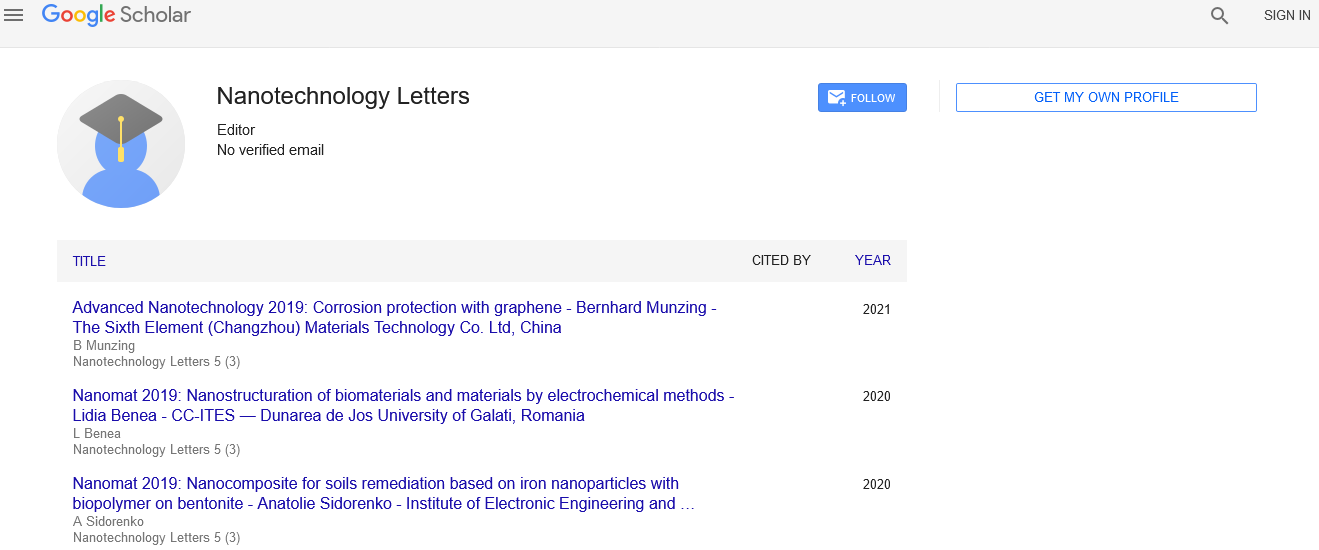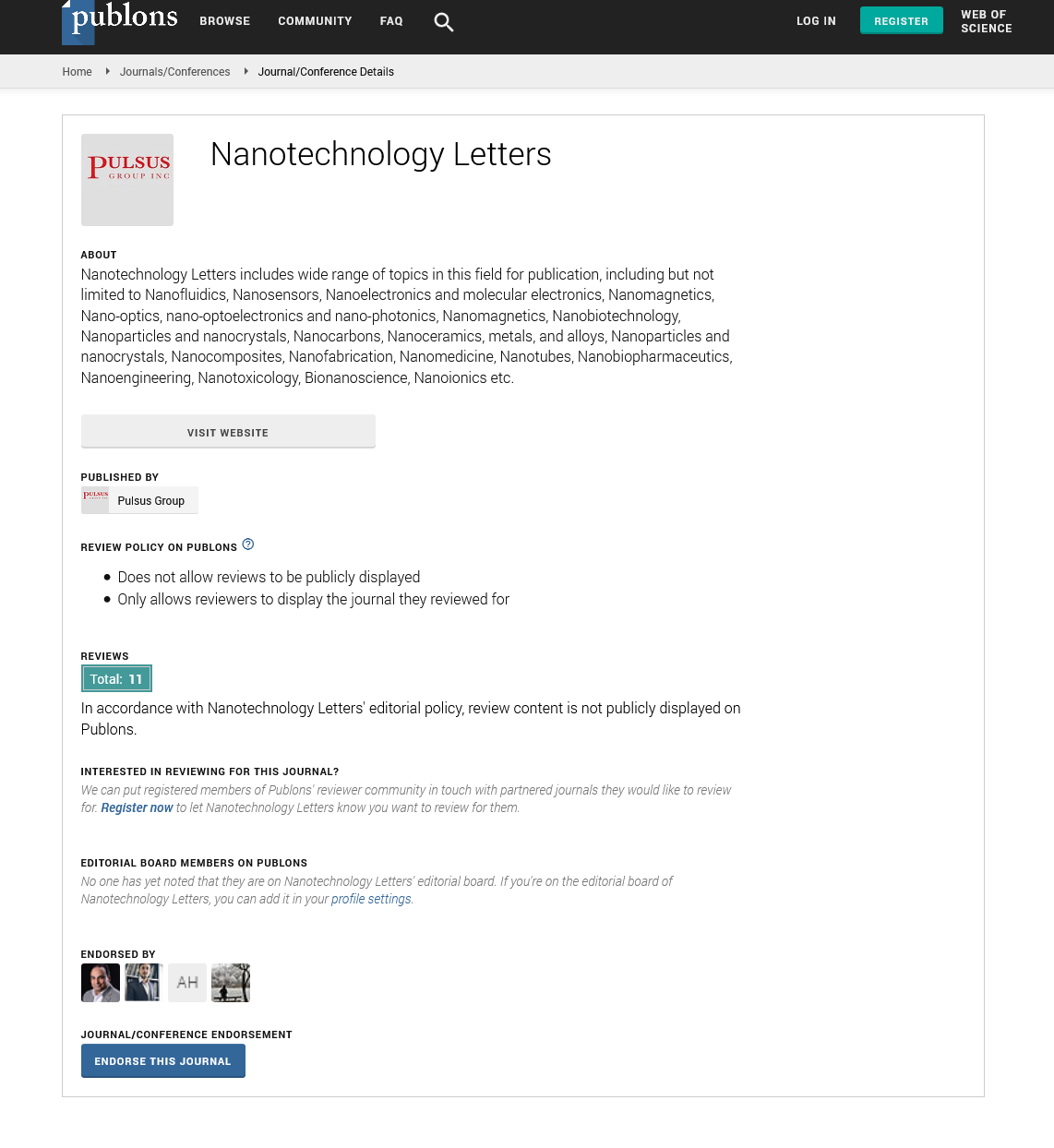Impact of pre-existing immunity to influenza on Live-attenuated influenza vaccine
Received: 08-Sep-2022, Manuscript No. PULNL-22-5613; Editor assigned: 10-Sep-2022, Pre QC No. PULNL-22-5613 (PQ); Accepted Date: Sep 24, 2022; Reviewed: 14-Sep-2022 QC No. PULNL-22-5613 (Q); Revised: 16-Sep-2022, Manuscript No. PULNL-22-5613 (R); Published: 26-Sep-2022, DOI: 10.37532. pulnl.22.7 (5).22-23
Citation: Shukla T. Impact of pre-existing immunity to influenza on live attenuated inflenza vaccine. Nanotechnol. lett.; 7(5):22-23.
This open-access article is distributed under the terms of the Creative Commons Attribution Non-Commercial License (CC BY-NC) (http://creativecommons.org/licenses/by-nc/4.0/), which permits reuse, distribution and reproduction of the article, provided that the original work is properly cited and the reuse is restricted to noncommercial purposes. For commercial reuse, contact reprints@pulsus.com
Abstract
Between 2010 and 2016, the Live Attenuated Influenza vaccine (LAIV) demonstrated varied effectiveness against influenza in the United States, leading to a recommendation against its use. In stark contrast, pre-clinical investigations have repeatedly proven that LAIV outperforms inactivated influenza vaccinations against mismatched Influenza Viruses (IIV). This difference in reported vaccination efficacies between pre-clinical and clinical research may be explained in part by the limitations of influenza animal models. The absence of pre-existing immunity in animal models, in particular, has lately emerged as a potential reason for inconsistencies between preclinical and human investigations. The purpose of this article is to discuss the possible influence of pre-existing immunity on LAIV-induced immunogenicity, with a focus on cross-protective immunity.
Introduction
Between 2010 and 2016, the live attenuated influenza vaccine (LAIV) demonstrated varied effectiveness against influenza in the United States, leading to a recommendation against its use. In stark contrast, pre-clinical investigations have repeatedly proven that LAIV outperforms inactivated influenza vaccinations against mismatched influenza viruses (IIV). This disparity in reported vaccine efficacies between pre-clinical and clinical studies may be explained in part by limitations of influenza animal models. The absence of pre-existing immunity in animal models, in particular, has recently emerged as a potential explanation for discrepancies between preclinical and human studies
Comparision of Live Attenuated Influenza Vaccine (LAIV) with inactivated influenza vaccines
The live attenuated influenza vaccine (LAIV) is administered by the natural route of influenza virus infection and replicates in nasal cells to generate broad immune responses that include both cellular and humoral protection. Although LAIV induces virus-specific cytotoxic CD8+ T lymphocytes (CTL), the systemic hemagglutinin (HA)- specific neutralising antibodies produced are often less than those produced by inactivated influenza vaccines (IIVs) . Local Immunoglobulin (Ig)A antibodies elicited following LAIV vaccination, on the other hand, have been shown in some studies to contribute to the suppression of influenza-associated morbidity and to protect against heterologous influenza viral strains. Parenteral administration of IIV, on the other hand, elicits excellent systemic IgG and IgM neutralising antibodies that primarily target the influenza virus HA and neuraminidase (NA) glycoproteins while promoting lower concentrations of neutralising IgA antibodies in the lung mucosa. Because LAIV is a full viral vaccine, it has a more diverse set of antigens, including internal proteins that are highly conserved across influenza A viruses.
In contrast, IIV is primarily composed of two highly variable viral surface antigens: HA and NA. In comparison to IIV, LAIV can better generate CD4+, CD8+, and T cell responses . Importantly, CD4+ helper T cells assist B and CD8+ T cells in promoting antiviral adaptive immunity (reviewed in). LAIV can also activate cytotoxic CD8+ T cells, which can recognise highly conserved epitopes from internal influenza proteins like nucleoprotein, acid polymerase, and matrix protein, and thus contribute to protection against mismatched, heterologous influenza virus strains . Furthermore, cytotoxic CD4+ T lymphocytes can react to core internal proteins. LAIV vaccination can induce this response which has been linked to increased heterotypic immunity.
In contrast, the ability of IIV to mount potent CD8+ T cell responses is less certain due to conflicting reports but IIV can afford enhanced CD4+ T cell responses, particularly follicular T helper cells, which are important for germinal centre B cell differentiation . LAIV has been demonstrated to produce cross-reactive plasmablasts and antibodies that can target the conserved epitopes on HA, including the stalk region . Antibodies against conserved regions, the stem, and the receptor binding site of HA are thought to be broadly cross-reactive among HA subtypes and thus may play a role in cross-protection.
LAIV has been demonstrated to generate non-neutralizing antibodies against the H7N9 strain, which may contribute to cross-protection through antibody-dependent cellular cytotoxicity (ADCC) mediated by Fc-FcR interactions . Although IIV failed to create cross-protective effectiveness against the 2009 pandemic H1N1 influenza , one study found that successive vaccination with antigenically different IIV can achieve partial cross- -protection mediated by non-neutralizing antibodies and CD8+ T cells in animal models.
Comparision of pre-clinical and clinical studies to find efficacy of LAIV
Commercially available LAIVs and experimental PandemicLAIVs (pLAIVs) have consistently demonstrated significant protection in animal models such as mice and ferrets (the most appealing small animal models that closely mimic human infection) against pandemic influenza virus strains: H1N1, H5N1, H5N2, H7N3, H2N2, and H7N9. These investigations found substantial control of viral multiplication in the respiratory tract, as well as strong serum HI antibodies and protection against homologous (vaccine strains) and heterologous strains, including mismatched/drifted influenza virus strains. Clinical investigations with a monovalent 2009 A/H1N1 LAIV in children indicated considerable protective effectiveness against the 2009 pandemic H1N1 influenza . Furthermore, in children, the trivalent LAIV demonstrated moderate to high effectiveness against influenza. The trivalent LAIV demonstrated significant protective effectiveness and immunogenicity against all three vaccine components: H1N1, H3N2, and influenza B virus in the latter experiments. In several flu seasons, trivalent LAIV was shown to be superior than IIV in a side-by-side comparison against antigenically similar and antigenically drifted influenza viruses.
The influence of pre-existing antibodies on LAIV T- cell immunogenicity
The replicative fitness of the temperature sensitive, live attenuated virus in the upper respiratory tract is one of the primary parameters determining LAIV immunogenicity .LAIV replication in nasal epithelial cells appears to be required for antigen presentation by the Major Histocompatibility Complex-I (MHC-I) to activate CD8+ T lymphocytes for efficient viral clearance. The thermal instability of the H1N1 LAIV strain (A/California/07/2009), which causes poor replication in human nasal cells , has been linked to lower LAIV effectiveness against the H1N1 virus. Indeed, in succeeding influenza seasons (2017-2018), change to a more stable, replication competent form of LAIV enhanced its potency. Despite increasing acknowledgement of the relevance of LAIV replication in LAIV immunogenicity, little is known about the detrimental effect of pre-existing immunity on LAIV replicative fitness. In Bangladesh, a clinical investigation found a link between stronger pre-existing baseline antibodies obtained from natural influenza A/H3N2 and B infections and minimal viral shedding/replication of LAIV . Furthermore, pre-existing antibodies acquired from past immunisation have been linked to decreased immunogenicity of LAIV These findings imply that pre-existing anti-vector immunity, most likely neutralising antibodies, plays an important role in suppressing antigen-specific cell-mediated immunity. Thus, it is critical to understand the immunological processes underpinning how preexisting antibodies influence LAIV-induced T cell responses in order to design improved vaccination regimens. This is especially important in light of the continuing COVID-19 outbreak. One of the COVID-19 vaccines now being developed in Hong Kong makes use of live attenuated influenza virus expressing SARS-CoV-2 antigens . Understanding the influence of pre-existing immunity on LAIVinfectivity of lung epithelia and antigen presentation by dendritic cells is critical in addition to examining immune suppressive processes. LAIV replication in nasal epithelial cells generates proinflammatory type 1 (Th1) related chemokines in the lungs, including chemokine (c-x-c motif) ligand (CXCL) 9 and CXCL11.
Such chemotactic mediators promote cellular infiltration of antigen-presenting cells (APCs) such as CD11b-dendritic cells (DCs), which are best known for their antigen crosspresentation to T cells, favouring Th1 responses for influenza viral clearance. Furthermore, research utilising influenza infection models revealed that CD11b+ conventional DCs (cDCs) and lung resident and cross-presenting CD11bcDCs play distinct roles in the activation of cross-protective T responses in mice. As a result, neutralisation of LAIV by pre-existing antibodies may inhibit effective infection of nasal epithelia, resulting in diminished Th1 inflammation and poor DC recruitment. Aside from pro-inflammatory innate immune responses in the lung mucosae, lung resident memory T and B cells have lately emerged as essential participants in influenza memory responses. It has recently been revealed that lung resident memory B cells (BRMs) and tissue resident memory T cells (TRMs) engage in cross-protection against influenza infection.
Conclusion
In conclusion, pre-existing influenza immunity has a considerable impact on LAIV efficacy against influenza viruses, contributing to the repeatedly observed varied efficacy of LAIV in clinical studies. Antibodies produced from IIV have been demonstrated to suppress influenza virus multiplication, resulting in decreased memory CD8+ T cell responses, which are critical for crossprotective immunity against antigenically drifted influenza strains. As a result, a similar mechanism could be contributing to the observed loss of LAIV's cross-protective efficacy in our recent IIV prime/LAIV boost study in mice. However, the precise mechanism by which pre-existing antibodies suppress LAIV T cell immunogenicity is unknown.
Key Words
Live attenuated influenza vaccine; Pre-existing immunity; T cell immunogenicity; Mucosal responses






